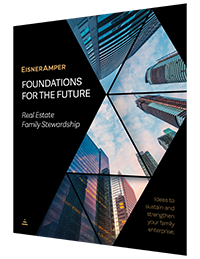
Part 3: A Dispute Resolution Guide for Real Estate Families
- Published
- Sep 14, 2020
- Share
 All family businesses, like all corporate organizations, experience periodic conflicts among owners. The root cause may be varying views on corporate strategy, the size of dividend payments, or unqualified family members wanting to be part of management. For real estate families, greater complexities arise from the web of perhaps hundreds of operating, borrowing, and property ownership entities in which each family member may own disparate shares. These ownership structures often bind real estate families together in a way that is illiquid and hard to escape, and it is inevitable that over time some family members may not be satisfied with the performance of the investments or may even want to free themselves from the web.
All family businesses, like all corporate organizations, experience periodic conflicts among owners. The root cause may be varying views on corporate strategy, the size of dividend payments, or unqualified family members wanting to be part of management. For real estate families, greater complexities arise from the web of perhaps hundreds of operating, borrowing, and property ownership entities in which each family member may own disparate shares. These ownership structures often bind real estate families together in a way that is illiquid and hard to escape, and it is inevitable that over time some family members may not be satisfied with the performance of the investments or may even want to free themselves from the web.
Beyond the buildings, entities and trusts are the family members themselves, each with their own lifestyle, goals and obligations. Decisions by family business leadership impact different family members in different ways. Not every family member may be happy with the outcome, and conflicts are certain to arise. That’s not necessarily a bad thing. Healthy conflict can help build productive, long-term relationships. On the other hand, unhealthy conflicts must be resolved quickly for the family to emerge even stronger and restore harmony. Families should know there are proven approaches to deal with any disputes that arise.
Negative conflict occurs when two or more individuals’ differences escalate to a level that adversely impacts productivity, morale, decision making, and family or company relationships. If not dealt with properly, the conflict can lead to open, often prolonged fighting that unleashes a vicious cycle of negative feelings among family members. Hence, the goal is to address the conflict quickly and openly, allowing family members to air their issues and ideas in a constructive manner. In that way, family leadership can work toward the resolution in a thoughtful and respectful manner.
While there are many approaches to conflict resolution, here is a straightforward, four-step process that will work in the context of complex real estate family relationships:
- The first step is to put the issues on the table: Allow the aggrieved parties to share their concerns and provide the context for the issue under dispute; occasionally, this frank discussion alone can reveal a path to resolution.
- The second step, perhaps with the support of a third-party family advisor or mediator, is to bring further detail to the problem and identify its root cause or catalyst. One way to narrow the scope of the dispute is to articulate what the problem is not
- Step three involves exploring solutions. It is often helpful not to try to find one specific solution, but rather develop a list of several alternative solutions along with the pros and cons of each. Then start to evaluate the proposed solutions to achieve a short list.
- Finally, in step four, the parties negotiate the selection of a short-listed solution as a way forward. They should try to achieve a win-win solution, and if that is not possible, strive for fairness to all participants.

Creating an environment of fairness in how disputes are resolved is essential to the long-term restoration of family harmony. Family leaders or mediators should not be perceived as taking sides but, rather, remaining objective and neutral while avoiding editorial or subjective comments. Discussions should be open and include all participants, with each given the chance to express their thoughts without interruption or criticism. Groups should not gang up on individuals, or make anyone feel intimidated. Along the way, document the process and its conclusion, with all parties agreeing to its accuracy to reduce the chance of misunderstandings.
The aforementioned process, or other step-by-step conflict resolution methodology, should be incorporated into the family governance charter. The charter could incorporate guidance on how a family member brings the issue to the attention of the family, perhaps through a designated person who handles disputes. The charter can also indicate which types of matters must be dealt with within the family and when an outside mediator should be involved. Finally, after the solution is negotiated, update the charter to include provisions for family approval of the agreed course of action and document the entirety of the process.
Conflict is a normal part of healthy relationships. Pretending to agree is often more harmful than a productive, active discussion where differences of opinion are aired and resolved. A family member who is kept in the dark about family business activities or believes they are not being heard is a potential dispute risk. Transparency of information and pre-established resolution processes may lead to a positive outcome. While not every family owner in a complex real estate business will be happy all the time, setting a tone of openness and mutual respect goes a long way toward avoiding major disagreements and preserving harmony.
Foundations for the Future: Real Estate Succession Planning
- Part 1: The Real Estate Family’s Considerations for Success
- Part 2: Considerations (or Opportunities) for Growing a Family Owned Real Estate
- Part 3: A Dispute Resolution Guide for Real Estate Families
- Part 4: More than Transferring a Title: How Do I Successfully Transfer Responsibility and Ownership of My Real Estate Empire?
Contact EisnerAmper
If you have any questions, we'd like to hear from you.
Receive the latest business insights, analysis, and perspectives from EisnerAmper professionals.











